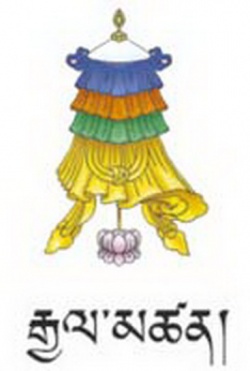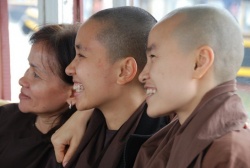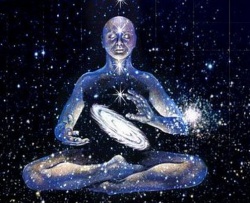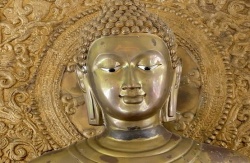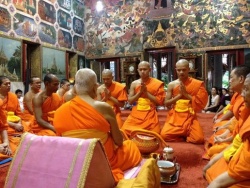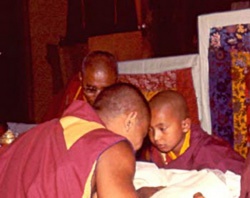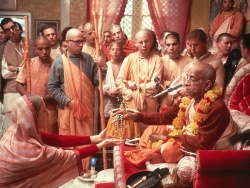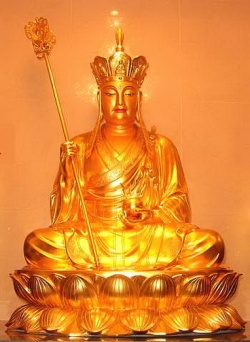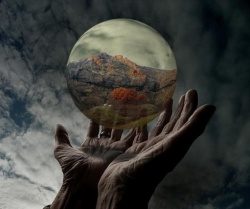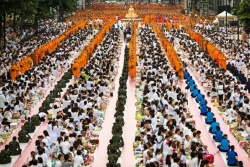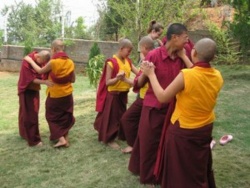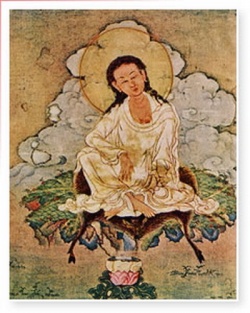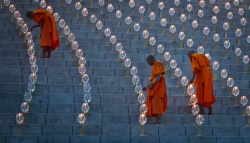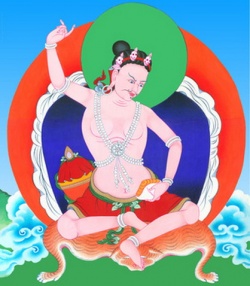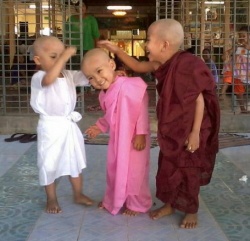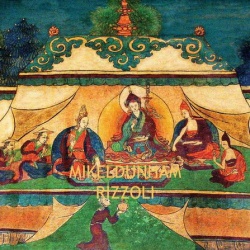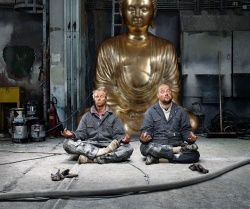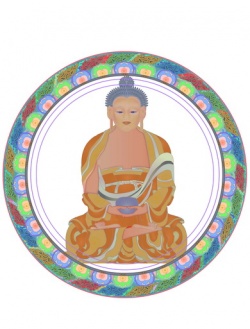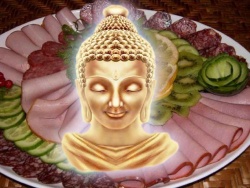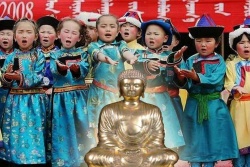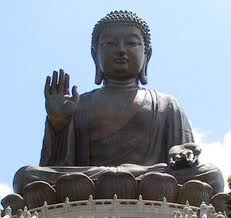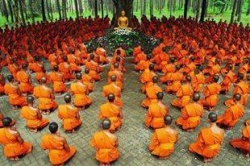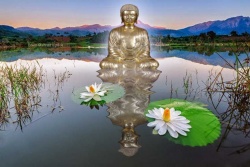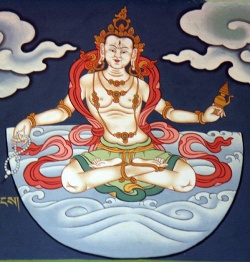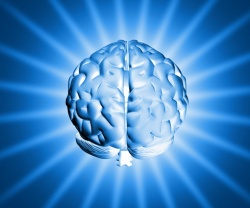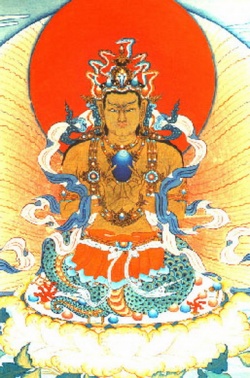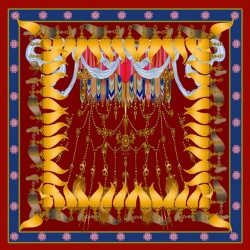Difference between revisions of "Kundalini Yoga of the Tantra"
(Created page with " Dr. Motilal Pandit Whatever the philosophical orientation of a Yogic school may be, the cultivation of the preliminary steps, as envisaged by the classical...") |
|||
| (7 intermediate revisions by the same user not shown) | |||
| Line 1: | Line 1: | ||
| + | <nomobile>{{DisplayImages|3776|3542|2915|1095|1106|2178|3348|430|2275|271|44|82|2348|2897|1639|2359|1564|2182|3002|3696|296|3682|3714|1315|3069|3745|3742|232|1875|2693|1868}}</nomobile> | ||
| + | Dr. Motilal [[Pandit]] | ||
| + | |||
| + | Whatever the [[philosophical]] orientation of a [[Yogic]] school may be, the [[cultivation]] of the preliminary steps, as envisaged by the classical [[Yoga]] School of [[Wikipedia:Patanjali|Patanjali's]], constitutes the basic foundation of every kind of [[yogic]] praxis. | ||
| + | |||
| + | The steps are so envisaged as would enable the [[practitioner]] to realize the [[soteriological]] goal of freedom. | ||
| + | |||
| + | The freedom that is sought concerns [[existence]] in the [[world]] itself. All [[Indian]] schools of [[thought]], whether [[orthodox]] or [[Wikipedia:Heterodoxy|heterodox]], are of the view that man will [[experience]] [[suffering]] to the extent he is not free, and this freedom is the [[Wikipedia:Absolute (philosophy)|ultimate]] goal of every [[yogic]] school. | ||
| + | |||
| + | Each [[yogic]] school, however, has its [[own]] [[understanding]] as to the [[nature]] of this freedom. | ||
| + | |||
| + | There, this, are different interpretations with regard to the [[nature]] of soteric freedom. Whatever be the [[interpretation]] concerning the [[nature]] of soteric freedom, all [[yogic]] schools agree that this [[transcendental]] freedom can be achieved only when [[consciousness]] is completely introverted. | ||
| + | |||
| + | In other words, it is in and through the process of {{Wiki|introversion}} of [[consciousness]] that [[embodied]] [[existence]] is transcended and this {{Wiki|transcendence}} is equated with the autonomy of the [[Self]]. | ||
| + | |||
| + | In [[order]] to facilitate the {{Wiki|transcendence}} of [[empirical]] [[existence]], the classical School of [[Yoga of Patanjali]] has devised certain {{Wiki|practical}} [[techniques]] by the use of which the ladder of {{Wiki|transcendence}} can be successfully ascended. | ||
| + | |||
| + | The [[yogic]] [[discipline]] of [[Wikipedia:Patanjali|Patanjali's]] consists of eight steps, and upon perfecting a particular step one automatically steps into the succeeding step. | ||
| + | |||
| + | This [[discipline]] of [[Wikipedia:Patanjali|Patanjali's]] with slight alterations, has been accepted by all [[yogic]] schools as the most appropriate method of enabling the {{Wiki|adept}} of gaining control over the [[senses]]. | ||
| + | |||
| + | Once control over the [[senses]] has been gained, it is not difficult for the [[yogi]] to reach his real goal, which is that of {{Wiki|introversion}} of [[consciousness]]. | ||
| + | |||
| + | |||
| + | The first two steps of the [[yogic]] [[discipline]] - [[Yama]] and [[Niyama]] are of [[ethical]] [[nature]], and so are of general import. | ||
| + | |||
| + | The thrust of these two steps is to enable the {{Wiki|adept}} to attain inner [[purity]] whereby the control of the [[mind]] may be facilitated. It is upon interiorizing the [[essential]] [[ethical]] {{Wiki|principles}} that the [[mind]] becomes [[one-pointed]], which means [[consciousness]] is saved from diffusion. | ||
| + | |||
| + | |||
| + | |||
| + | The real [[yogic]] [[discipline]] begins from the third step, which is that of ‘[[posture]]’ ([[āsana]]). | ||
| + | |||
| + | For a [[Tāntrika]], a [[posture]] does not simply signify as to what kind of [[bodily]] position the [[practitioner]] of [[meditation]] should make us of while [[meditating]]. For him [[posture]] has a broader significance and meaning than what occurs in the classical [[Yoga of Patanjali]]. | ||
| + | |||
| + | For a [[Tāntrika]], it is [[essential]] to interiorize the [[physical]] [[posture]]. | ||
| + | |||
| + | Upon interiorizing the [[posture]], a [[Tāntrika]] directs his [[attention]] upon the “central point” ([[madhyamā]]) that [[exists]] between the exhaling and inhaling breaths, between two [[thoughts]], or between two [[actions]]. | ||
| + | |||
| + | This focusing of [[attention]] upon the central point results in the [[emergence]] of what the [[Tantra]] calls inner [[posture]]. | ||
| + | |||
| + | It becomes abundantly clear that [[Tantra]] is not so much concerned with the external aspects of [[Yogic]] [[techniques]] as much as with their inner [[essence]]. | ||
| + | |||
| + | It is for this [[reason]] that great {{Wiki|emphasis}} has been laid upon the interiorization of [[techniques]]. This [[practice]] of fixing [[attention]] upon the central point corresponds to the [[Buddhist practice]] of [[mindfulness]] ([[smṛti]]). | ||
| + | |||
| + | While laying {{Wiki|emphasis}} upon the [[essence]] of [[techniques]], [[Tantra]] does not neglect the external aspects of [[Yogic]] [[methods]]. It [[recognizes]] the fact that interiorization of [[posture]] is not possible unless the [[art]] of [[physical]] [[posture]] is perfected. | ||
| + | |||
| + | |||
| + | |||
| + | It is upon gaining [[perfection]] in the external aspect of the [[posture]] that a [[Tāntrika]] attempts at internalizing it. | ||
| + | |||
| + | The interiorization of the [[posture]] (āntarika [[āsana]]) is accomplished by fixing [[awareness]] upon the middle point of two breaths, or two [[thoughts]] or two [[actions]]. | ||
| + | |||
| + | It is upon the pathway of the [[breath]] that a [[Tāntrika]] is asked to maintain a continuous [[awareness]] on and in the center of the inhaling and exhaling breaths. It is this process of fixing [[awareness]] on the central point that is really called the internal [[posture]]. | ||
| + | |||
| + | |||
| + | For a [[Tāntrika]] the [[idea]] of “central point” fundamentally denotes the ‘point of {{Wiki|conjunction}}’ or ‘meeting’ ([[samādhi]]). | ||
| + | |||
| + | The interiorization of the [[posture]] is completely dependent to what extent [[awareness]] upon the central point has continuously been maintained and fixed. Insofar as the fixing of [[attention]] is concerned, it has to ensure from the beginning to the end of two breaths. | ||
| + | |||
| + | A [[Tāntrika]] is however warned not to engage in this [[practice]] either during the night or day. | ||
| + | |||
| + | The suitable [[time]] for this [[practice]] is that of {{Wiki|twilight}}, which is that of dawn or dusk. It is upon gaining [[perfection]] in internalizing [[posture]] that a [[Tāntrika]] steps into [[the fourth]] limb ([[aṅga]]) of [[Yogic]] [[discipline]], which is that of [[Prāṇāyāma]] or [[breath control]]. | ||
| + | |||
| + | The leap from the [[physical]] [[posture]] to that of [[breath control]] is gained the [[moment]] the [[Tāntrika]] succeeds in maintaining a continuous [[awareness]] of the central point of incoming and outgoing breaths. | ||
| + | |||
| + | It is by fixing [[awareness]] on the central point that the [[breath]] of the {{Wiki|adept}} becomes, progressively and spontaneously, refined. It is the refinement of [[breath]] that elevates the {{Wiki|adept}} to another [[world]], which is that of [[Prāṇāyāma]]. | ||
| + | |||
| + | As to how to be established gainfully in the [[state]] of [[Prāṇāyāma]], [[Tantra]] has devised two [[methods]] namely [[Ajapā Gāyatrī]] and that of [[Chakrodaya]]. | ||
| + | |||
| + | The {{Wiki|adept}}, while engaged in the [[practice]] of the former method, is asked to remain {{Wiki|aware}} on the points where the outgoing and incoming breaths begin and end. | ||
| + | |||
| + | The [[awareness]] has to be continuous and unbroken. | ||
| + | |||
| + | [[Tantra]], however, [[recognizes]] that this method is difficult to [[practice]] as very few {{Wiki|adepts}} succeed in perfecting the [[art]] of maintaining an unbroken chain of [[awareness]] concerning the central point. | ||
| + | |||
| + | As this method is difficult to [[practice]], so a [[Tāntrika]] is asked to [[practice]] another method, which is that of [[Chakrodaya]] or the method of ‘the [[emergence]] of the [[wheel]]’. | ||
| + | |||
| + | Being less cumbersome and difficult, a [[Tāntrika]] {{Wiki|adept}} finds it easier to [[practice]]. | ||
| + | |||
| + | While practicing this method, the {{Wiki|adept}} is asked to cultivate [[awareness]] in such a [[manner]] as would not result in external or internal {{Wiki|exertion}}. | ||
| + | |||
| + | The [[awareness]] has to be such a kind that would emerge by itself spontaneously from the center from where the two breaths begin and end. | ||
| + | |||
| + | |||
| + | |||
| + | Our normal [[breathing]] is always coarse, rough and irregular. | ||
| + | |||
| + | The {{Wiki|adept}}, on account of the coarseness of breaths, is unable to maintain continuous [[awareness]] upon the central point of breaths. | ||
| + | |||
| + | It is the refinement of [[breath]] that is seen by the [[Tāntrika]] as the only means of enabling the {{Wiki|adept}} to fix his [[attention]] upon the central point of breaths. | ||
| + | |||
| + | It is in and through the [[practice]] of [[Chakrodaya]] that a [[Tāntrika]] expects to effect refinement in the process of his [[breathing]]. | ||
| + | |||
| + | The scale of refinement in [[breathing]] is [[realized]] to what extent the span of breaths have been lengthened. | ||
| + | |||
| + | And the lengthening of breaths is [[dependent upon]] [[Prāṇāyāma]]. | ||
| + | |||
| + | According to [[Tantra]], a lengthened {{Wiki|inhalation}} or {{Wiki|exhalation}} occupies less [[space]], whereas the shorter ones are believed to be occupying more [[space]]. | ||
| + | |||
| + | The {{Wiki|purpose}} of refining the breaths as well as of fixing [[attention]] upon the central point is to effect {{Wiki|introversion}} of [[consciousness]]. | ||
| + | |||
| + | The [[Tāntrika]] attains the [[powers]] of omnipotence and of {{Wiki|omnipresence}} when one has arrived at the [[condition]] whereby the [[space]] of breaths is reduced by one tuṭi. | ||
| + | |||
| + | It is through the [[practice]] of [[Chakrodaya]] that the {{Wiki|movement}} of [[breath]] is lengthened and thereby is reduced the [[space]] that short breaths occupy. | ||
| + | |||
| + | Further the [[practitioner]] of [[Chakrodaya]] is asked that, while lengthening the span of breaths, he must inhale and exhale in such a [[manner]] as would result in the audibility of the [[emerging]] [[sound]], which means that the internal [[sound]] should be audible to those who may be sitting nearby. | ||
| + | |||
| + | |||
| + | |||
| + | Insofar as the commencement of ascendent and descendent breaths is concerned, there are differing [[views]] among the practitioners of [[Tantra]]. One school of [[thought]] is of the view that “[[heart]]” should conduct the incoming and outgoing breaths. | ||
| + | |||
| + | The other school of [[thought]] [[thinks]] that it should be the “{{Wiki|throat}}” from where the breaths should commence. | ||
| + | |||
| + | Most followers of [[Tantra]] think that it is very [[dangerous]] to engage in such a [[practice]] that allows the [[breath]] to originate from the [[heart]]. | ||
| + | |||
| + | Experts in the [[art]] of [[Tantric]] praxis believe that this [[practice]] terminates in the [[emergence]] of heat in the [[heart]]. | ||
| + | |||
| + | The heat not only damages the [[heart]], but also leads to [[mental]] derangement. Even there is the [[danger]] of [[death]] for the one who does not handle this [[practice]] with [[care]]. The [[Tāntrika]] thus is advised to abandon such practices that can be fatal and [[dangerous]]. | ||
| + | |||
| + | Most of the [[Tāntrikasa]], therefore, prefer the least harmful practices which in the {{Wiki|present}} context means that it should be the {{Wiki|throat}} that should conduct or control [[breathing]]. | ||
| + | |||
| + | |||
| + | Upon deepening the {{Wiki|introversion}} of [[consciousness]] through the process of {{Wiki|inhalation}} and {{Wiki|exhalation}} in terms of fixing [[awareness]] upon the central point, the {{Wiki|adept}} thereby is in a position of [[abandoning]] the normal [[states of consciousness]] namely, the states of waking ([[jāgrat]]), deep [[sleep]] ([[suṣupti]]) and [[Wikipedia:Dream|dreaming]] ([[svapna]]). | ||
| + | |||
| + | Upon the [[abandonment]] of the normal or [[empirical]] modes of [[consciousness]], the {{Wiki|adept}} steps into what is called the Fourth ([[turīya]]). The Fourth is a [[state of consciousness]] that emerges at the {{Wiki|conjunction}} of [[empirical]] [[states of consciousness]]. | ||
| + | |||
| + | |||
| + | |||
| + | Once the proficiency and expertise in the technique of [[breath control]] is gained, the {{Wiki|adept}} thereby is ready to move onto the next [[yogic]] disciplinary step, which is that of [[mental]] {{Wiki|abstraction}} or [[Pratyāhāra]]. | ||
| + | |||
| + | The deepening of {{Wiki|introversion}} of [[consciousness]] is made effective to the extent the technique of [[mental]] {{Wiki|abstraction}} is cultivated intensely. | ||
| + | |||
| + | There is, thus a direct link between the {{Wiki|introversion}} of [[consciousness]] and [[mental]] {{Wiki|abstraction}}. | ||
| + | |||
| + | There is all the possibility of experiencing giddiness or [[sleep]] at the level of [[Prāṇāyāma]], but such type of [[experiences]] do not occur at the level of [[mental]] {{Wiki|abstraction}}. | ||
| + | |||
| + | Instead of [[sleep]] or giddiness, the {{Wiki|adept}} may [[experience]] a kind of {{Wiki|inertia}} seeping into this {{Wiki|organs}} of [[action]] ([[karmendriya]]). | ||
| + | |||
| + | The {{Wiki|inertia}} could be of such a [[nature]] that the {{Wiki|organs}} of [[action]] might become lifeless, that is, totally [[dead]] to the external {{Wiki|stimulus}}. | ||
| + | |||
| + | The {{Wiki|organs}} of [[action]] thus lose the capacity of {{Wiki|initiating}} any [[form]] of [[action]]. Insofar as the [[organs of perception]] ([[jñānendriya]]) are concerned, they too lose their capacity of functioning in a normal way. | ||
| + | |||
| + | Whatever one sees or hears or touches is indistinct and hazy. The [[mind]] goes blank, which means it loses the capacity of making any kind of [[judgement]] or of making use of the will. | ||
| + | |||
| + | This [[state]] may be compared to the one which sleepwalking represents. | ||
| + | |||
| + | All these [[experiences]] indicate that the {{Wiki|adept}} is calling off himself from his immediate {{Wiki|environment}}. It also means that [[consciousness]], by turning upon itself, sinks into its [[own]] [[Wikipedia:Abyss (religion)|abyss]]. | ||
| + | |||
| + | These [[experiences]] also indicate that the {{Wiki|adept}} is ready to step into the [[state]] of the Fourth or [[Turīya]]. | ||
| + | |||
| + | Upon gaining entrance into the Fourth [[state]], the {{Wiki|adept}} thereby loses complete [[interest]] in what is out there. | ||
| + | |||
| + | This lack of [[interest]] in the outside [[world]] is the sign of inward journey. | ||
| + | |||
| + | It is in terms of the inward journey that the {{Wiki|adept}} attempts to explore the inner [[realms]] of [[consciousness]]. | ||
| + | |||
| + | |||
| + | |||
| + | The {{Wiki|adept}} upon the commencement of interior journey, is given the opportunity of gaining access to such [[experiences]] that are free from the coarseness of [[empirical]] [[experiences]]. | ||
| + | |||
| + | Since the inward [[experiences]] are of {{Wiki|subtle}} [[nature]], so it means that no coarse [[element]] [[exists]] in it. It is the subtlest aspect ([[tanmātra]]) of the [[five elements]] that the {{Wiki|adept}} is enabled to have [[experience]] of. | ||
| + | |||
| + | To have the [[experience]] of the {{Wiki|subtle}} aspects of the [[elements]] means that [[consciousness]] has achieved the [[highest degree]] of [[purity]] and refinement. | ||
| + | |||
| + | This refinement is directly linked to what [[degree]] [[consciousness]] has been, in the [[ascetic]] furnace of interior [[meditation]], [[purified]]. | ||
| + | |||
| + | The [[purity]] of [[consciousness]] [[empowers]] the {{Wiki|adept}} to have the [[experience]] even of the {{Wiki|subtle}} aspects of [[sound]], {{Wiki|smell}} and {{Wiki|touch}}. | ||
| + | |||
| + | To arrive at the {{Wiki|subtle}} aspect of an [[element]], within the [[yogic]] parlance, denotes that the [[experience]] is of the [[nature]] of [[delight]]. The [[experience]] is as delightful as occurs at the height of {{Wiki|sexual}} {{Wiki|orgasm}}. | ||
| + | |||
| + | Although permeated by the {{Wiki|flavor}} ([[rasa]]) of [[delight]], such [[experiences]] are not seen as the sure [[signs]] of [[spiritual]] advancement. | ||
| + | |||
| + | They are, instead, viewed as impediments in the way of [[spiritual]] progress, because they distract the {{Wiki|adept}} from the goal towards which he is expected to move. | ||
| + | |||
| + | The {{Wiki|adept}} subsequently goes astray and engages in such [[activities]] that terminate in the [[birth]] of non-freedom, that is bondage. The {{Wiki|adept}} is hence warned not to seek or run after these [[experiences]] of [[delight]]. | ||
| + | |||
| + | The access to the [[state]] that is [[mental]] is opened up the [[moment]] the subtleness of [[elements]] is internally produced, and as a consequence of this the unwinding of the [[mind]] occurs with great [[awareness]]. | ||
| + | |||
| + | Accordingly the {{Wiki|adept}} enters the [[state]] of [[Supreme]] [[Consciousness]]. | ||
| + | |||
| + | [[Thus]] is facilitated the [[emergence]] of the [[state]] of [[mental]] [[repose]] or [[Pratyāhāra]]. | ||
| + | |||
| + | |||
| + | |||
| + | The {{Wiki|adept}} sinks into the interior [[repose]] of [[consciousness]] to the measure he successfully overcomes the impediments that come to be due to the delightful [[experiences]]. | ||
| + | |||
| + | The very turning away from [[experiences]] that are delightful in [[nature]] [[empowers]] the {{Wiki|adept}} of sundering even the subtlest links with the [[world]]. | ||
| + | |||
| + | Accordingly, [[Pratyāhāra]], both as a [[state]] and as a technique, has been defined as that process whereby one efficaciously actualizes the sundering of bondage with [[saṃsāra]]. | ||
| + | |||
| + | The delinking of [[consciousness]] from the [[external world]] also means that [[consciousness]] is completely emptied of contents of [[empirical knowledge]]. | ||
| + | |||
| + | The absence of external content in [[consciousness]] facilitates the passage for the [[arising]] of [[knowledge]] that is true (ṛtambharā), which means that the {{Wiki|adept}} now [[knows]] the real as it is in itself. | ||
| + | |||
| + | At this point of {{Wiki|introversion}} or inwardness the {{Wiki|movement}} of [[breath]] slows down to the minimum, and consequently the [[state]] of complete {{Wiki|abstraction}} or [[Dhyāna]] is entered. | ||
| + | |||
| + | |||
| + | |||
| + | Prior to stepping into the [[state]] of [[dhyāna]], the {{Wiki|movement}} of [[breath]] enters the central [[mystical]] [[channel]] of [[Suṣumnā nāḍī]] and from there the [[breath]] rushes downward to the [[root]] [[Mūlādhāra chakra]] where the [[Kuṇḍalinī]] is supposed to be {{Wiki|lying}} in the [[state]] of {{Wiki|inertia}} or [[sleep]]. | ||
| + | |||
| + | It is in the [[state]] of [[dhyāna]] in which the arousal of the [[Kuṇḍalinī]] is [[initiated]]. | ||
| + | |||
| + | The [[awakening]] of the [[Kuṇḍalinī]] is not possible unless all the [[yogic]] steps are traversed successfully. | ||
| + | |||
| + | At the same [[time]] complete expertise in the [[yogic]] [[techniques]] has to be gained before the [[breath]] enters the [[central channel]]. | ||
| + | |||
| + | The [[state]] of [[dhyāna]] thus corresponds to the [[awakening]] of [[Kuṇḍalinī]] itself. | ||
| + | |||
| + | In the [[Spandakārikā]] (1.2.24) of [[Kallaṭa]] the equating of [[dhyāna]] with the entrance of [[breath]] into the [[central channel]] is described thus: | ||
| + | |||
| + | “When the [[Yogi]] confirms internally that he will do whatever the [[state]] of [[Supreme]] [[Consciousness]] wills, and when he takes hold of the [[sound]] [[element]] ([[spanda tattva]]), his [[breathing]] enters the [[central channel]] and rises again in the upward [[path]] (ūrdhvamārga) as [[Kuṇḍalinī]].” | ||
| + | |||
| + | |||
| + | |||
| + | Upon [[attaining]] the [[state]] of [[Dhyāna]], the {{Wiki|adept}}, for all {{Wiki|practical}} purposes, {{Wiki|transcends}} the normal, or what we may call [[empirical]] mode of [[perception]]. {{Wiki|Transcendence}} of normal [[cognition]] denotes that one loses the [[sense]] of one’s [[Wikipedia:Identity (social science)|identity]]. | ||
| + | |||
| + | At this [[meditative]] level, the process of [[visualization]] as well as of [[breathing]] comes to complete standstill. | ||
| + | |||
| + | The [[meditative absorption]] is no more [[dependent upon]] the focusing of [[attention]] upon the central point. The {{Wiki|adept}} has gained such [[meditative]] {{Wiki|dexterity}} that [[absorption]] occurs spontaneously. | ||
| − | + | Also the [[absorption]] is so deep that every [[form]] of [[mental]] process ceases to [[function]]. | |
| + | |||
| + | As a result of the [[cessation]] of [[mental processes]] the adept’s [[body]] is charged with an electric like current. | ||
| + | |||
| + | Such charging of the [[body]] results in the [[emergence]] of such an [[experience]] that is characterized by the [[shock]] of [[wonder]] (camatkāra). | ||
| + | |||
| + | The [[experience]] of [[bliss]], of [[joy]], of [[wonder]] in the [[form]] of [[shock]], is termed as the [[initiation]] of [[penetration]] ([[videha dīkṣā]]). We shall explain as to what this [[initiation]] denotes while discussing the arousal of [[Prāṇa]] [[Kuṇḍalinī]]. | ||
| + | |||
| + | |||
| + | |||
| + | The [[initiation]] of [[penetration]] is of six types. The seventh one is the final one. | ||
| + | |||
| + | When the {{Wiki|adept}} reaches the final [[initiation]] of [[penetration]], it means that the [[Kuṇḍalinī]] has reached her final destination, which is the top of the [[skull]], and which is the abode of [[Shiva]]. | ||
| + | |||
| + | Once [[Kuṇḍalinī]] reaches the top of the head, the {{Wiki|adept}} thereby steps from [[dhyāna]] into the next limb of [[Yoga]], which is that of [[Dhāraṇā]]. [[Dhāraṇā]] is that absorptive [[state]] in which the [[mind]] establishes itself firmly in the internal [[reality]] of [[Supreme]] [[Consciousness]]. | ||
| + | |||
| + | At this level, the [[practitioner]] of [[meditation]] is asked to adjust to the new situation which has emerged on account of trans-empirical [[cognition]]. | ||
| + | |||
| + | This [[cognition]] results in the {{Wiki|monistic}} view of [[reality]] that asserts the [[essential]] [[correspondence]] between the [[microcosm]] and the [[macrocosm]], between the [[universal]] and the {{Wiki|individual}}, between [[saṃsāra]] and [[nirvāṇa]]. | ||
| + | |||
| + | For a [[tāntrika]] [[yogi]], it means that the [[phenomenal world]], prior to its [[emanation]] or [[manifestation]], [[exists]] as a latent seed in the [[Absolute]], and the [[Absolute]] is [[nothing]] else but [[Shiva]], or what in [[philosophical]] [[language]] is called as I-Consciousness. | ||
| + | |||
| + | |||
| + | |||
| + | The [[body]] of the {{Wiki|adept}}, at this point of [[experience]], is charged with [[energy]]. | ||
| + | |||
| + | |||
| + | The process of [[breathing]], too, regains [[life]]. All this indicates that the {{Wiki|adept}} has become {{Wiki|proficient}} in the [[art]] of [[absorption]]. | ||
| + | |||
| + | No {{Wiki|exertion}} of any kind is involved in reaching the [[state]] of [[absorption]]. | ||
| + | |||
| + | It is spontaneous. While externalizing his [[awareness]], the {{Wiki|adept}} thereby does not abrogate [[awareness]]. In whatever [[condition]] he may be, he is always in the [[state]] of [[absorption]]. | ||
| + | |||
| + | Whether eating, [[sleeping]] or walking, the {{Wiki|adept}} remains constantly in the [[state]] of the Fourth or the [[Turīya]]. Accordingly this [[state]] is referred to as that of [[bliss]] that is [[cosmic]] in [[nature]] ([[Jagadānanda]]). | ||
| + | |||
| + | |||
| + | |||
| + | From the [[state]] of [[Dhāraṇā]] the {{Wiki|adept}} enters, without any [[effort]] or impediment into the final [[meditative state]], which is of {{Wiki|indeterminate}} [[nature]]. | ||
| + | |||
| + | This [[meditative]] {{Wiki|indeterminate}} [[state of consciousness]] is technically called the [[Nirvikalpa Samādhi]]. It is so spoken because no content is to be found in [[consciousness]]. | ||
| + | |||
| + | For this [[reason]], this [[state]] is also spoken of as a [[state]] in which the process of [[thinking]] is completely absent. It is upon reaching this {{Wiki|indeterminate}} [[state of consciousness]] that the {{Wiki|adept}} [[experiences]] the merger of the [[Kuṇḍalinī]] with [[Shiva]]. | ||
| + | |||
| + | This merger of the [[Kuṇḍalinī]] with [[Shiva]] [[empowers]] the {{Wiki|adept}} to have the {{Wiki|taste}} of the [[immortal]] [[nectar]]. | ||
| + | |||
| + | Upon [[tasting]] the [[immortal]] [[nectar]] the {{Wiki|adept}} attains the [[deathless state]], a [[state]] that results in the [[experience]] of the [[dissolution]] of the [[cosmos]] into what is called I-Consciousness. | ||
| + | |||
| + | |||
| + | |||
| + | The [[ascent]] of [[Kuṇḍalinī]] thus corresponds to the deepening of [[consciousness]] through [[meditative absorption]] into oneself. This sinking of [[consciousness]] into oneself terminates in the termination of all links with the outside [[world]]. | ||
| + | |||
| + | The merger of the [[Kuṇḍalinī]] into [[Shiva]] {{Wiki|signifies}} for a [[Tāntrika]], at the level of [[experience]], the [[dissolution]] of the [[universe]] in terms of which resorptive {{Wiki|movement}}, in contrast to the emissional one, is actualized by [[Shiva]]. | ||
| + | |||
| + | |||
| + | |||
| + | [[Tantra]] has made a tripartite [[division]] of the [[Kuṇḍalinī]]. This [[division]] corresponds to the three levels of [[manifestation]] as well as well as to the three aspects of the [[Ultimate Reality]]. | ||
| + | |||
| + | The three aspects of the [[Kuṇḍalinī]] are known as the [[Parā Kuṇḍalinī]], the [[Chit Kuṇḍalinī]] and the [[Shakti Kuṇḍalinī]]. | ||
| + | |||
| + | [[Kuṇḍalinī]] is the innate [[power]] responsible for [[giving]] rise to the [[manifest]] [[realm]] by atomizing [[Shiva]] into a multitude of entities. | ||
| + | |||
| + | While atomizing [[Shiva]], [[Kuṇḍalinī]] itself gets atomized. | ||
| + | |||
| + | The [[Parā Kuṇḍalinī]] represents the [[transcendent]] [[state]] of [[Reality]], and this [[state]] is characterized by non-differentiation. | ||
| + | |||
| + | It is a [[state]] of non-difference and so no [[bifurcation]] [[exists]], at this level, in Being. | ||
| + | |||
| + | As the innate [[power]] of [[Shiva]], [[Parā Kuṇḍalinī]] is that [[energy]] of [[Shiva]] through which the [[manifestation]] of emission ([[Visarga]]) occurs. [[Symbolically]], this [[state]] is represented by by the two dots one upon the other (:),denoting thereby the [[Divine]] Couple as [[Shiva]] and [[Shakti]]. | ||
| + | |||
| + | The [[esoteric]] significance of the two dots indicates the revealing and concealing [[powers]] of the [[Divine]]. | ||
| + | |||
| + | |||
| + | The Parā [[Kuṇḍalinī]] as the [[absolute]] creatrix, gives rise to the [[objective world]] not because of external compulsion or internal necessity, but because of her sovereign freedom and will. | ||
| + | |||
| + | |||
| + | As sovereign, She can equally choose or not choose to emit the [[universe]] out of Herself. | ||
| + | |||
| + | Prior to the actual projection or [[manifestation]] of the [[universe]], the innate sovereign freedom ([[svātantrya]]) of the Parā [[Kuṇḍalinī]] is so externalized as would make it possible for the ejection of the sprout of a fertilized seed. | ||
| + | |||
| + | This process of externalization of creative freedom of the [[Goddess]] as [[Kuṇḍalinī]] may be termed as the first phase of creational [[manifestation]]. | ||
| + | |||
| + | It is in the second phase of the creative [[activity]] of the [[Goddess]] that the emission of the [[objective]] [[universe]] is [[initiated]]. | ||
| + | |||
| + | In the third phase emission of the [[universe]] is actualized at the point when the [[absolute]] [[power]] and freedom of the [[Goddess]] are objectified. | ||
| + | |||
| + | It is the innate [[power]] of the Parā [[Kuṇḍalinī]] as the [[Goddess]] which the [[Tāntrikas]] consider as the basic [[cause]] for the [[emanation]] of the objectified [[universe]]. | ||
| + | |||
| + | |||
| + | |||
| + | The [[Goddess]] as [[Parā Kuṇḍalinī]] constitutes the [[absolute]] freedom as well as will ([[icchā]]) of [[Shiva]]. | ||
| + | |||
| + | It is the [[absolute]] will of [[Shiva]] which, while responsible for {{Wiki|initiating}} the process of the [[universe]], is spoken of as [[Shakti]]. | ||
| + | |||
| + | The [[Parā Kuṇḍalinī]] at the [[metaphysical]] level, is the [[embodiment]] of [[absolute]] freedom and will, and so is accordingly seen as representing the [[essential nature]] of [[Shiva]]. | ||
| + | |||
| + | The [[Parā Kuṇḍalinī]], upon the [[manifestation]] of [[universe]], atomizes herself as the [[sleeping]] [[energy]], of which the coiled {{Wiki|snake}} is the [[symbol]]. | ||
| + | |||
| + | It is this [[atomic]] aspect of [[Parā Kuṇḍalinī]] that is known as the [[Shakti Kuṇḍalinī]]. | ||
| + | |||
| + | It is as [[Shakti Kuṇḍalinī]] that the [[Parā Kuṇḍalinī]] is [[thought]] to be [[source of light]] ([[prakāśa]]) of [[consciousness]] ([[chit]]). | ||
| + | |||
| + | As and when the term ‘[[light]]’ is made use of, it denotes that [[power]] by which [[consciousness]] is enabled to have the [[knowledge]] of itself as well as of what is out there. | ||
| + | |||
| + | It is as [[light]] that [[knowledge]] expresses itself through five [[forms]] of [[sound]], {{Wiki|touch}}, [[form]], {{Wiki|taste}} and {{Wiki|smell}}. | ||
| + | |||
| + | These five modes of apprehending [[knowledge]] correspond to the five [[sensations]] of [[seeing]], {{Wiki|touch}}, [[hearing]], {{Wiki|taste}} and {{Wiki|smell}}. The [[Shakti Kuṇḍalinī]] represents the creative aspect of the [[Parā Kuṇḍalinī]] and accordingly is considered to the seventeenth [[kalā]] of the supreme [[nectar]]. | ||
| + | |||
| + | |||
| + | |||
| + | The [[infinitude]] of [[Parā Kuṇḍalinī]] cannot be [[experienced]] by the {{Wiki|adept}} on account of him [[being]] [[subject]] to the limitations of [[embodied]] [[existence]]. | ||
| + | |||
| + | That which consists of [[body]] [[suffers]] continuously from the {{Wiki|temporal}} succession of change. | ||
| + | |||
| + | The [[body]] of the {{Wiki|adept}} too, is [[subject]] to {{Wiki|temporal}} change, which means that it is as finite as any other material [[entity]]. | ||
| + | |||
| + | It is impossible for the finite [[entity]] to comprehend or [[experience]] that which is [[infinite]], [[beyond]] the {{Wiki|temporal}} succession of change and [[unlimited]]. | ||
| + | |||
| + | The limited [[body]] of the {{Wiki|adept}} has no capacity or [[power]] of experiencing the [[infinite]]. | ||
| + | |||
| + | The {{Wiki|adept}} has the possibility of experiencing the [[infinitude]] of the Parā [[Kuṇḍalinī]] at the [[time]] of [[death]], that is, at the [[time]] when he is in the process of discarding his [[embodied]] [[existence]]. | ||
| + | |||
| + | As and when the {{Wiki|adept}} has the [[experience]] of the [[Parā Kuṇḍalinī]] his [[experience]] of her is in terms of what the [[tāntrikas]] call internal [[samādhi]]. | ||
| + | |||
| + | The [[experience]] that the {{Wiki|adept}} has of [[Parā Kuṇḍalinī]] is in terms of {{Wiki|unity}} of Being, that is, the [[macrocosm]] and the [[microcosm]] are [[experienced]] as [[being]] [[identical]]. | ||
| + | |||
| + | This [[experience]] of [[Wikipedia:Identity (social science)|identity]] or {{Wiki|unity}} is technically called the [[Krama]] [[Mudrā]]. | ||
| + | |||
| + | |||
| + | |||
| + | The [[bliss]] that results from this [[experience]] is of [[cosmic]] [[nature]]. | ||
| + | |||
| + | |||
| + | |||
| + | The difference between the [[experience]] of the [[Parā Kuṇḍalinī]], the [[Shakti Kuṇḍalinī]], the [[Chit Kuṇḍalinī]] and the [[Prāṇa Kuṇḍalinī]] is in the following. | ||
| + | |||
| + | Upon the [[awakening]] of [[Shakti Kuṇḍalinī]] the [[energy]] of [[breath]] that enters the [[central channel]] does not {{Wiki|touch}} the {{Wiki|spinal cord}}. | ||
| + | |||
| + | It goes, rather, upward without any impediment or interruption. | ||
| + | |||
| + | In the case of [[Chit Kuṇḍalinī]] or [[Prāṇā Kuṇḍalinī]] the [[energy]] of ([[prāṇa]] [[śakti]]) has to penetrate the [[Chakras]] along the {{Wiki|spinal cord}}. | ||
| + | |||
| + | It is upon the [[penetration]] of the [[Chakras]] that the [[path]] for [[Kuṇḍalinī]] is cleared from all obstructions. | ||
| + | |||
| + | Once the [[path]] is cleared of all obstruction, the [[Kuṇḍalinī]] ascends, with ease, upward till it reaches the top of head where She merges in [[Shiva]]. | ||
| + | |||
| + | |||
| + | |||
| + | Next to the [[Parā Kuṇḍalinī]] is the [[Chit Kuṇḍalinī]] which, as the [[embodiment]] of [[energy]], [[empowers]] {{Wiki|individual}} [[beings]] with the [[power]] of [[awareness]]. | ||
| + | |||
| + | An {{Wiki|adept}} gains the capacity of experiencing the [[Chit Kuṇḍalinī]] by employing the various [[Yogic]] [[techniques]] and one of them is that of the [[Chakrodaya]]. | ||
| + | |||
| + | This technique consists of focusing the [[attention]] on the central point, or what is called the point of {{Wiki|conjunction}}. This point is one where two breaths, two [[thoughts]] or two [[actions]] meet and conjugate. | ||
| + | |||
| + | The point of {{Wiki|conjunction}} ([[madhyama]]) is equated with the [[void]] ([[śūnya]]) of [[space]]. | ||
| + | |||
| + | The {{Wiki|concept}} of [[void]] or [[śūnya]] is considered by the [[tāntrikas]] as the [[symbol]] of unimpeded freedom. | ||
| + | |||
| + | Since the [[void]] of [[space]] and the point of {{Wiki|conjunction}} are [[identical]], so it means that the [[latter]] too, represents [[absolute]] freedom of [[Shiva]]. | ||
| + | |||
| + | It is by [[meditating]] on this central point that the {{Wiki|adept}} by going inward, gains the necessary [[power]] of interiorizing the extroverted [[consciousness]]. Upon having sufficiently turned [[consciousness]] inward, the {{Wiki|adept}} thereby is in a position of experiencing the [[Chit]] [[Kuṇḍalinī]]. | ||
| + | |||
| + | The process of interiorizing of [[consciousness]] begins in the following way. An {{Wiki|adept}}, through a focused and deep [[concentration]], enters the point of {{Wiki|conjunction}}. | ||
| + | |||
| + | With the deepening of interiority of [[consciousness]] there occurs the slow pace of pulse, of the circulation of {{Wiki|blood}}, and of the [[breath]] {{Wiki|movement}}. | ||
| + | |||
| + | There also arises within the crawling [[sensation]] as well as the humming [[sound]] of a bee. This [[experience]] results in the rise of intense [[delight]]. | ||
| + | |||
| + | |||
| + | |||
| + | In addition to [[Chakrodaya]], there is another method which consists of pushing the incoming and outgoing breaths into the [[central channel]]. At the initial stage the breaths may be allowed to descend a little downward. | ||
| + | |||
| + | Upon gaining [[mastery]] over this technique, the {{Wiki|adept}} is asked to collect the breaths at that point where they may slip down to the [[Mūlādhāra Chakra]]. | ||
| + | |||
| + | The point at which the breaths are collected or unified is known as the point of [[Laṃbikā]]. | ||
| + | |||
| + | When the breaths are unified and are ready to descend downward, there occurs the [[cessation]] of [[breathing]], which results in the experiencing of choking [[sensation]]. | ||
| + | |||
| + | At this point of [[experience]] the right side of [[Laṃbikā]] opens up, which facilitates the breaths to descend downward. | ||
| + | |||
| + | The normal [[breathing]] on the right side of [[Laṃbikā]] remains blocked. | ||
| + | |||
| + | The passage to the right side of [[Laṃbikā]] is opened up through the [[practice]] of refined deep [[concentration]]. | ||
| + | |||
| + | As a consequence of intense [[concentration]] the breaths are unified, and accordingly are allowed to reach the [[Mūlādhāra Chakra]]. | ||
| + | |||
| + | |||
| + | |||
| + | Once the collected breaths enter, through the right side passage of [[Laṃbikā]], into the [[central channel]], there emerges such a type of vibration that is [[experienced]] upon the closure of the opening of [[ears]]. | ||
| + | |||
| + | |||
| + | |||
| + | The breaths, once in the [[Mūlādhāra Chakra]], arouse the [[Kuṇḍalinī]] from her [[sleep]]. | ||
| + | |||
| + | The [[awakening]] of [[Kuṇḍalinī]] results in the [[penetration]] of the [[Mūlādhāra Chakra]]. | ||
| + | |||
| + | Once penetrated by [[Kuṇḍalinī]] it begins to revolve {{Wiki|clockwise}} at an unimaginable {{Wiki|speed}}. | ||
| + | |||
| + | It is the first [[Wikipedia:Authenticity|authentic]] [[experience]] that a [[practitioner]] [[experiences]] upon the arousal of [[Kuṇḍalinī]]. | ||
| + | |||
| + | |||
| + | |||
| + | The breaths as a unified whole become one with the [[Kuṇḍalinī]] upon reaching the lowest [[Chakra]]. | ||
| + | |||
| + | Once in this [[Chakra]], they facilitate the arousal of [[Kuṇḍalinī]] from the [[state]] of [[sleep]] in which she finds herself upon becoming atomized by reducing herself to the [[manifest]] categories or [[Tattvas]]. | ||
| + | |||
| + | The [[Kuṇḍalinī]], upon arousal moves upwards from the lowest [[Chakra]] towards the [[navel]] or [[Nābhi Chakra]]. | ||
| + | |||
| + | Once here, the [[Kuṇḍalinī]] penetrates it and consequently makes it rotate like [[a wheel]]. | ||
| + | |||
| + | At the same [[time]] the [[Yogi]] [[experiences]] as if both the [[Mūlādhāra Chakra]] and the [[Maṇipūraka Chakra]] are revolving simultaneously and together. While both the [[wheels]] revolve, they produce such vibratory {{Wiki|sounds}} that are so [[pleasing]] that they enrapture the [[mind]]. | ||
| + | |||
| + | |||
| + | |||
| + | From the [[navel]] [[wheel]] the [[Kuṇḍalinī]] moves onto the next [[Chakra]], which is known as the [[heart]] or [[Heart Chakra]]. | ||
| + | |||
| + | While penetrating this [[wheel]] of [[energy]], the [[Kuṇḍalinī]] makes it revolve along with the other two [[wheels]] that lie below it. The [[experience]] that the [[Yogi]] has is that of rotating {{Wiki|movement}} of all the three [[Chakras]] or [[wheels]]. | ||
| + | |||
| + | The [[Yogi]] even [[experiences]] the presence of the spokes of the [[wheels]]. | ||
| + | |||
| + | From this [[wheel]] of [[energy]] the [[Kuṇḍalinī]] moves onto the next [[Chakra]], which lies n the {{Wiki|throat}} and is accordingly known as the Kaṇṭha [[Chakra]]. | ||
| + | |||
| + | From the {{Wiki|throat}} [[wheel]], She moves onto the [[wheel]] of [[energy]] that lies between the two [[eyebrows]] ([[bhrūmadhya]]). | ||
| + | |||
| + | The [[Kuṇḍalinī]] does not move any further for such practitioners who are solely [[interested]] in [[worldly]] [[pleasures]], that is, in the [[attainment]] of [[Siddhis]] etc. | ||
| + | |||
| + | In case of such practitioners who are desirous of [[liberation]] from [[human]] bondage, the [[Kuṇḍalinī]] however, moves towards the top of the head. Upon reaching the top of the head, the [[Kuṇḍalinī]] no more has an atomized [[existence]]. | ||
| + | |||
| + | By merging in the [[Supreme]] [[Consciousness]], which is [[Paramashiva]], she attains the undifferentiated [[condition]], which for the [[yogi]] means that he no more [[experiences]] himself to be separate from his [[Wikipedia:Ontology|ontological]] ground. | ||
| + | |||
| + | This merger, at the {{Wiki|anthropomorphic}} level, is seen as the unification of the [[Divine]] Couple, that is, of [[Shiva]] and [[Shakti]]. | ||
| + | |||
| + | Also this unification is equated with the [[experience]] of {{Wiki|unity}} that occurs between {{Wiki|male}} and {{Wiki|female}} when engaged in {{Wiki|sexual}} intercourse. | ||
| + | |||
| + | The resultant orgasmic like [[delight]] is termed as ‘the celebration of supreme union’ ([[Mahāmelāpa]]). This [[pleasurable]] [[experience]] is said to be of the [[nature]] of [[nectar]]. | ||
| + | |||
| + | Upon drinking the [[immortal]] [[nectar]] of [[bliss]], the [[yogi]] thereby has the [[experience]] of the soteric [[bliss]], or the [[bliss]] that emerges upon [[attaining]] the [[state]] of [[liberation]]. | ||
| + | |||
| + | |||
| + | |||
| + | The [[Yogi]], while engaged in the [[practice]] of the arousal of [[Kuṇḍalinī]] from her [[state]] of dormancy, should remain {{Wiki|cautious}} of the fact that the arousal must not take place in the reverse [[order]]. | ||
| + | |||
| + | Such an arousal is said to be of ghostly [[nature]] ([[piśācāveśa]]). | ||
| + | |||
| + | If the arousal occurs in a reverse [[order]], then the [[Kuṇḍalinī]] does not move upward from the [[Mūlādhāra Chakra]] to the top of head. | ||
| + | |||
| + | Rather the {{Wiki|movement}} of the [[energy]] of the [[breath]] is downward from the middle of the [[eyebrows]] to the [[Mūlādhāra Chakra]]. | ||
| + | |||
| + | Such an arousal is not at all beneficial. It may prove fatal to the well-being of the [[Yogi]]. | ||
| + | |||
| + | |||
| + | |||
| + | Once [[awakened]], [[Kuṇḍalinī]] moves upward. | ||
| + | |||
| + | |||
| + | In her upward journey she penetrates all the [[Chakras]] that are located along the {{Wiki|spinal cord}}. This process of [[penetration]] of [[wheels]] of [[energy]] is known as the piercing [[initiation]] of [[Vedha Dīkṣā]]. | ||
| + | |||
| + | The [[penetration]] that occurs is [[dependent upon]] the inner dispositions of the [[Yogi]] that he may be having at the [[time]] of the [[penetration]]. | ||
| + | |||
| + | [[Abhinavagupta]] describes this process of [[penetration]] in the following words: | ||
| + | |||
| + | “This [[initiation]] of [[penetration]] is described in different ways in the [[Tantras]]. | ||
| + | |||
| + | Here the [[Yogi]] has to [[experience]] the [[initiation]] of [[penetration]] whereby he rises from one [[Chakra]] to another. | ||
| − | + | As a consequence of this, he simultaneously [[experiences]] the [[Chakras]] in {{Wiki|motion}}. | |
| − | + | Subsequently, on account of this [[penetration]], possesses the eight [[powers]].” | |
| − | |||
| − | |||
| − | + | The nuber of penetrations corresponds to the number of [[wheels]] of [[energy]], which are said to be six. | |
| − | + | Each [[penetration]] gives rise to an [[experience]] that is appropriate to it. The first [[penetration]] is known as [[Mantra Vedha]]. | |
| − | + | This [[penetration]] occurs in [[Yogi]] of such type who is desirous of experiencing the fullness of I-[[Consciousness]]. | |
| − | + | As a consequence of [[Mantra Vedha]], the [[Yogi]] has the [[experience]] of the [[rising]] of [[Prāṇa]] [[Kuṇḍalinī]] in the [[form]] of [[Mantra]]. | |
| − | Upon | + | Upon the [[emergence]] of [[Kuṇḍalinī]] in the [[form]] of [[Mantra]], there occurs the [[experience]] that is [[joyful]] and full of [[delight]]. |
| − | + | The [[breath]] of [[joy]], upon its [[emergence]], penetrates all the [[Chakras]] from the [[Mūlādhāra]] to the [[Sahasrāra]]. | |
| − | |||
| − | |||
| − | + | The second kind of [[penetration]] is called [[Nāda Vedha]] or the [[penetration]] by [[Sound]]. | |
| − | + | This kind of [[penetration]] occurs in such a [[Yogi]] who is desirous of leading [[people]] to the [[soteriological]] goal of [[liberation]]. | |
| − | + | Insofar as the arousal of [[Kuṇḍalinī]] is concerned, it takes place in the [[form]] of [[Nāda]] or [[Sound]]. | |
| − | + | As the [[sound]] is constitutive of [[speech]], so it is through the spoken [[word]] ([[Mantra]]) that the [[Yogi]] is [[empowered]] to explain and describe the [[nature]] of the [[Absolute]]. | |
| − | |||
| − | |||
| − | + | The third [[penetration]] is known as [[Bindu Vedha]]. This [[penetration]] is actualized in [[Yogis]] of such type who seek [[sensual pleasures]] and [[occult]] [[powers]]. | |
| − | + | In [[Yogis]] of this type the [[joyful]] [[breath]] is [[transformed]] into semen ([[vīrya]]). | |
| − | The [[ | + | The [[Yogi]] of this type, upon the arousal of [[Prāṇa Kuṇḍalinī]], [[experiences]] the pervasion of semen from the bottom [[Chakra]] to the top one. |
| − | The | + | The {{Wiki|ecstatic}} [[delight]] that occurs on account of the presence of semen is equated with the [[delight]] that one [[experiences]] at the height of {{Wiki|sexual}} {{Wiki|orgasm}}. |
| − | The | + | The fourth [[penetration]] is called [[śākta vedha]] or energetic [[penetration]]. |
| − | + | This penetrative [[initiation]] occurs in [[Yogis]] who want to be strong both {{Wiki|physically}} and [[mentally]]. | |
| − | |||
| − | |||
| − | The | + | The [[Yogi]] of this type [[experiences]] the upward {{Wiki|movement}} of the [[Kuṇḍalinī]] to be like that of an ant. Also he [[experiences]] the [[transformation]] of [[breath]] into [[pure]] [[energy]]. |
| − | + | As a consequence of this [[experience]], he [[thinks]] of himself as the [[embodiment]] of [[pure]] [[energy]]. | |
| − | + | Even the [[sound]] that emerges upon the arousal of [[Kuṇḍalinī]] is of the [[nature]] of an electric current. | |
| − | |||
| − | |||
| − | The | + | The fifth [[penetration]] is known as [[Bhujaṅga Vedha]] or the snake-life [[penetration]]. |
| − | + | This type of [[penetration]] is actualized in such [[Yogis]] who [[visualize]] [[Kuṇḍalinī]] in the [[form]] of a {{Wiki|snake}}. | |
| − | The | + | The arousal of [[Kuṇḍalinī]] in [[Yogis]] of such type occurs in the [[form]] of a {{Wiki|snake}}. Upon its arousal, the [[Kuṇḍalinī]] as {{Wiki|snake}}, when stretching upwards, keeps its tail in the [[lowest Chakra]]. |
| − | The | + | The last penetrative [[initiation]] is known as [[Parā Vedha]] or [[transcendental penetration]]. This [[penetration]] is for the [[Yogi]] who is desirous of [[nothing]] else than to have the [[experience]] of the presence of [[Shiva]]. |
| − | + | The [[Yogi]] who has this [[penetration]] sinks into the [[repose]] of all {{Wiki|pervasive}} I-Consciousness which is [[nothing]] else by [[Shiva]] itself. | |
{{R}} | {{R}} | ||
[http://www.kamakotimandali.com/blog/index.php?p=1412&more=1&c=1&tb=1&pb=1] | [http://www.kamakotimandali.com/blog/index.php?p=1412&more=1&c=1&tb=1&pb=1] | ||
[[Category:Kundalini]] | [[Category:Kundalini]] | ||
Latest revision as of 17:34, 26 March 2023
Dr. Motilal Pandit
Whatever the philosophical orientation of a Yogic school may be, the cultivation of the preliminary steps, as envisaged by the classical Yoga School of Patanjali's, constitutes the basic foundation of every kind of yogic praxis.
The steps are so envisaged as would enable the practitioner to realize the soteriological goal of freedom.
The freedom that is sought concerns existence in the world itself. All Indian schools of thought, whether orthodox or heterodox, are of the view that man will experience suffering to the extent he is not free, and this freedom is the ultimate goal of every yogic school.
Each yogic school, however, has its own understanding as to the nature of this freedom.
There, this, are different interpretations with regard to the nature of soteric freedom. Whatever be the interpretation concerning the nature of soteric freedom, all yogic schools agree that this transcendental freedom can be achieved only when consciousness is completely introverted.
In other words, it is in and through the process of introversion of consciousness that embodied existence is transcended and this transcendence is equated with the autonomy of the Self.
In order to facilitate the transcendence of empirical existence, the classical School of Yoga of Patanjali has devised certain practical techniques by the use of which the ladder of transcendence can be successfully ascended.
The yogic discipline of Patanjali's consists of eight steps, and upon perfecting a particular step one automatically steps into the succeeding step.
This discipline of Patanjali's with slight alterations, has been accepted by all yogic schools as the most appropriate method of enabling the adept of gaining control over the senses.
Once control over the senses has been gained, it is not difficult for the yogi to reach his real goal, which is that of introversion of consciousness.
The first two steps of the yogic discipline - Yama and Niyama are of ethical nature, and so are of general import.
The thrust of these two steps is to enable the adept to attain inner purity whereby the control of the mind may be facilitated. It is upon interiorizing the essential ethical principles that the mind becomes one-pointed, which means consciousness is saved from diffusion.
The real yogic discipline begins from the third step, which is that of ‘posture’ (āsana).
For a Tāntrika, a posture does not simply signify as to what kind of bodily position the practitioner of meditation should make us of while meditating. For him posture has a broader significance and meaning than what occurs in the classical Yoga of Patanjali.
For a Tāntrika, it is essential to interiorize the physical posture.
Upon interiorizing the posture, a Tāntrika directs his attention upon the “central point” (madhyamā) that exists between the exhaling and inhaling breaths, between two thoughts, or between two actions.
This focusing of attention upon the central point results in the emergence of what the Tantra calls inner posture.
It becomes abundantly clear that Tantra is not so much concerned with the external aspects of Yogic techniques as much as with their inner essence.
It is for this reason that great emphasis has been laid upon the interiorization of techniques. This practice of fixing attention upon the central point corresponds to the Buddhist practice of mindfulness (smṛti).
While laying emphasis upon the essence of techniques, Tantra does not neglect the external aspects of Yogic methods. It recognizes the fact that interiorization of posture is not possible unless the art of physical posture is perfected.
It is upon gaining perfection in the external aspect of the posture that a Tāntrika attempts at internalizing it.
The interiorization of the posture (āntarika āsana) is accomplished by fixing awareness upon the middle point of two breaths, or two thoughts or two actions.
It is upon the pathway of the breath that a Tāntrika is asked to maintain a continuous awareness on and in the center of the inhaling and exhaling breaths. It is this process of fixing awareness on the central point that is really called the internal posture.
For a Tāntrika the idea of “central point” fundamentally denotes the ‘point of conjunction’ or ‘meeting’ (samādhi).
The interiorization of the posture is completely dependent to what extent awareness upon the central point has continuously been maintained and fixed. Insofar as the fixing of attention is concerned, it has to ensure from the beginning to the end of two breaths.
A Tāntrika is however warned not to engage in this practice either during the night or day.
The suitable time for this practice is that of twilight, which is that of dawn or dusk. It is upon gaining perfection in internalizing posture that a Tāntrika steps into the fourth limb (aṅga) of Yogic discipline, which is that of Prāṇāyāma or breath control.
The leap from the physical posture to that of breath control is gained the moment the Tāntrika succeeds in maintaining a continuous awareness of the central point of incoming and outgoing breaths.
It is by fixing awareness on the central point that the breath of the adept becomes, progressively and spontaneously, refined. It is the refinement of breath that elevates the adept to another world, which is that of Prāṇāyāma.
As to how to be established gainfully in the state of Prāṇāyāma, Tantra has devised two methods namely Ajapā Gāyatrī and that of Chakrodaya.
The adept, while engaged in the practice of the former method, is asked to remain aware on the points where the outgoing and incoming breaths begin and end.
The awareness has to be continuous and unbroken.
Tantra, however, recognizes that this method is difficult to practice as very few adepts succeed in perfecting the art of maintaining an unbroken chain of awareness concerning the central point.
As this method is difficult to practice, so a Tāntrika is asked to practice another method, which is that of Chakrodaya or the method of ‘the emergence of the wheel’.
Being less cumbersome and difficult, a Tāntrika adept finds it easier to practice.
While practicing this method, the adept is asked to cultivate awareness in such a manner as would not result in external or internal exertion.
The awareness has to be such a kind that would emerge by itself spontaneously from the center from where the two breaths begin and end.
Our normal breathing is always coarse, rough and irregular.
The adept, on account of the coarseness of breaths, is unable to maintain continuous awareness upon the central point of breaths.
It is the refinement of breath that is seen by the Tāntrika as the only means of enabling the adept to fix his attention upon the central point of breaths.
It is in and through the practice of Chakrodaya that a Tāntrika expects to effect refinement in the process of his breathing.
The scale of refinement in breathing is realized to what extent the span of breaths have been lengthened.
And the lengthening of breaths is dependent upon Prāṇāyāma.
According to Tantra, a lengthened inhalation or exhalation occupies less space, whereas the shorter ones are believed to be occupying more space.
The purpose of refining the breaths as well as of fixing attention upon the central point is to effect introversion of consciousness.
The Tāntrika attains the powers of omnipotence and of omnipresence when one has arrived at the condition whereby the space of breaths is reduced by one tuṭi.
It is through the practice of Chakrodaya that the movement of breath is lengthened and thereby is reduced the space that short breaths occupy.
Further the practitioner of Chakrodaya is asked that, while lengthening the span of breaths, he must inhale and exhale in such a manner as would result in the audibility of the emerging sound, which means that the internal sound should be audible to those who may be sitting nearby.
Insofar as the commencement of ascendent and descendent breaths is concerned, there are differing views among the practitioners of Tantra. One school of thought is of the view that “heart” should conduct the incoming and outgoing breaths.
The other school of thought thinks that it should be the “throat” from where the breaths should commence.
Most followers of Tantra think that it is very dangerous to engage in such a practice that allows the breath to originate from the heart.
Experts in the art of Tantric praxis believe that this practice terminates in the emergence of heat in the heart.
The heat not only damages the heart, but also leads to mental derangement. Even there is the danger of death for the one who does not handle this practice with care. The Tāntrika thus is advised to abandon such practices that can be fatal and dangerous.
Most of the Tāntrikasa, therefore, prefer the least harmful practices which in the present context means that it should be the throat that should conduct or control breathing.
Upon deepening the introversion of consciousness through the process of inhalation and exhalation in terms of fixing awareness upon the central point, the adept thereby is in a position of abandoning the normal states of consciousness namely, the states of waking (jāgrat), deep sleep (suṣupti) and dreaming (svapna).
Upon the abandonment of the normal or empirical modes of consciousness, the adept steps into what is called the Fourth (turīya). The Fourth is a state of consciousness that emerges at the conjunction of empirical states of consciousness.
Once the proficiency and expertise in the technique of breath control is gained, the adept thereby is ready to move onto the next yogic disciplinary step, which is that of mental abstraction or Pratyāhāra.
The deepening of introversion of consciousness is made effective to the extent the technique of mental abstraction is cultivated intensely.
There is, thus a direct link between the introversion of consciousness and mental abstraction.
There is all the possibility of experiencing giddiness or sleep at the level of Prāṇāyāma, but such type of experiences do not occur at the level of mental abstraction.
Instead of sleep or giddiness, the adept may experience a kind of inertia seeping into this organs of action (karmendriya).
The inertia could be of such a nature that the organs of action might become lifeless, that is, totally dead to the external stimulus.
The organs of action thus lose the capacity of initiating any form of action. Insofar as the organs of perception (jñānendriya) are concerned, they too lose their capacity of functioning in a normal way.
Whatever one sees or hears or touches is indistinct and hazy. The mind goes blank, which means it loses the capacity of making any kind of judgement or of making use of the will.
This state may be compared to the one which sleepwalking represents.
All these experiences indicate that the adept is calling off himself from his immediate environment. It also means that consciousness, by turning upon itself, sinks into its own abyss.
These experiences also indicate that the adept is ready to step into the state of the Fourth or Turīya.
Upon gaining entrance into the Fourth state, the adept thereby loses complete interest in what is out there.
This lack of interest in the outside world is the sign of inward journey.
It is in terms of the inward journey that the adept attempts to explore the inner realms of consciousness.
The adept upon the commencement of interior journey, is given the opportunity of gaining access to such experiences that are free from the coarseness of empirical experiences.
Since the inward experiences are of subtle nature, so it means that no coarse element exists in it. It is the subtlest aspect (tanmātra) of the five elements that the adept is enabled to have experience of.
To have the experience of the subtle aspects of the elements means that consciousness has achieved the highest degree of purity and refinement.
This refinement is directly linked to what degree consciousness has been, in the ascetic furnace of interior meditation, purified.
The purity of consciousness empowers the adept to have the experience even of the subtle aspects of sound, smell and touch.
To arrive at the subtle aspect of an element, within the yogic parlance, denotes that the experience is of the nature of delight. The experience is as delightful as occurs at the height of sexual orgasm.
Although permeated by the flavor (rasa) of delight, such experiences are not seen as the sure signs of spiritual advancement.
They are, instead, viewed as impediments in the way of spiritual progress, because they distract the adept from the goal towards which he is expected to move.
The adept subsequently goes astray and engages in such activities that terminate in the birth of non-freedom, that is bondage. The adept is hence warned not to seek or run after these experiences of delight.
The access to the state that is mental is opened up the moment the subtleness of elements is internally produced, and as a consequence of this the unwinding of the mind occurs with great awareness.
Accordingly the adept enters the state of Supreme Consciousness.
Thus is facilitated the emergence of the state of mental repose or Pratyāhāra.
The adept sinks into the interior repose of consciousness to the measure he successfully overcomes the impediments that come to be due to the delightful experiences.
The very turning away from experiences that are delightful in nature empowers the adept of sundering even the subtlest links with the world.
Accordingly, Pratyāhāra, both as a state and as a technique, has been defined as that process whereby one efficaciously actualizes the sundering of bondage with saṃsāra.
The delinking of consciousness from the external world also means that consciousness is completely emptied of contents of empirical knowledge.
The absence of external content in consciousness facilitates the passage for the arising of knowledge that is true (ṛtambharā), which means that the adept now knows the real as it is in itself.
At this point of introversion or inwardness the movement of breath slows down to the minimum, and consequently the state of complete abstraction or Dhyāna is entered.
Prior to stepping into the state of dhyāna, the movement of breath enters the central mystical channel of Suṣumnā nāḍī and from there the breath rushes downward to the root Mūlādhāra chakra where the Kuṇḍalinī is supposed to be lying in the state of inertia or sleep.
It is in the state of dhyāna in which the arousal of the Kuṇḍalinī is initiated.
The awakening of the Kuṇḍalinī is not possible unless all the yogic steps are traversed successfully.
At the same time complete expertise in the yogic techniques has to be gained before the breath enters the central channel.
The state of dhyāna thus corresponds to the awakening of Kuṇḍalinī itself.
In the Spandakārikā (1.2.24) of Kallaṭa the equating of dhyāna with the entrance of breath into the central channel is described thus:
“When the Yogi confirms internally that he will do whatever the state of Supreme Consciousness wills, and when he takes hold of the sound element (spanda tattva), his breathing enters the central channel and rises again in the upward path (ūrdhvamārga) as Kuṇḍalinī.”
Upon attaining the state of Dhyāna, the adept, for all practical purposes, transcends the normal, or what we may call empirical mode of perception. Transcendence of normal cognition denotes that one loses the sense of one’s identity.
At this meditative level, the process of visualization as well as of breathing comes to complete standstill.
The meditative absorption is no more dependent upon the focusing of attention upon the central point. The adept has gained such meditative dexterity that absorption occurs spontaneously.
Also the absorption is so deep that every form of mental process ceases to function.
As a result of the cessation of mental processes the adept’s body is charged with an electric like current.
Such charging of the body results in the emergence of such an experience that is characterized by the shock of wonder (camatkāra).
The experience of bliss, of joy, of wonder in the form of shock, is termed as the initiation of penetration (videha dīkṣā). We shall explain as to what this initiation denotes while discussing the arousal of Prāṇa Kuṇḍalinī.
The initiation of penetration is of six types. The seventh one is the final one.
When the adept reaches the final initiation of penetration, it means that the Kuṇḍalinī has reached her final destination, which is the top of the skull, and which is the abode of Shiva.
Once Kuṇḍalinī reaches the top of the head, the adept thereby steps from dhyāna into the next limb of Yoga, which is that of Dhāraṇā. Dhāraṇā is that absorptive state in which the mind establishes itself firmly in the internal reality of Supreme Consciousness.
At this level, the practitioner of meditation is asked to adjust to the new situation which has emerged on account of trans-empirical cognition.
This cognition results in the monistic view of reality that asserts the essential correspondence between the microcosm and the macrocosm, between the universal and the individual, between saṃsāra and nirvāṇa.
For a tāntrika yogi, it means that the phenomenal world, prior to its emanation or manifestation, exists as a latent seed in the Absolute, and the Absolute is nothing else but Shiva, or what in philosophical language is called as I-Consciousness.
The body of the adept, at this point of experience, is charged with energy.
The process of breathing, too, regains life. All this indicates that the adept has become proficient in the art of absorption.
No exertion of any kind is involved in reaching the state of absorption.
It is spontaneous. While externalizing his awareness, the adept thereby does not abrogate awareness. In whatever condition he may be, he is always in the state of absorption.
Whether eating, sleeping or walking, the adept remains constantly in the state of the Fourth or the Turīya. Accordingly this state is referred to as that of bliss that is cosmic in nature (Jagadānanda).
From the state of Dhāraṇā the adept enters, without any effort or impediment into the final meditative state, which is of indeterminate nature.
This meditative indeterminate state of consciousness is technically called the Nirvikalpa Samādhi. It is so spoken because no content is to be found in consciousness.
For this reason, this state is also spoken of as a state in which the process of thinking is completely absent. It is upon reaching this indeterminate state of consciousness that the adept experiences the merger of the Kuṇḍalinī with Shiva.
This merger of the Kuṇḍalinī with Shiva empowers the adept to have the taste of the immortal nectar.
Upon tasting the immortal nectar the adept attains the deathless state, a state that results in the experience of the dissolution of the cosmos into what is called I-Consciousness.
The ascent of Kuṇḍalinī thus corresponds to the deepening of consciousness through meditative absorption into oneself. This sinking of consciousness into oneself terminates in the termination of all links with the outside world.
The merger of the Kuṇḍalinī into Shiva signifies for a Tāntrika, at the level of experience, the dissolution of the universe in terms of which resorptive movement, in contrast to the emissional one, is actualized by Shiva.
Tantra has made a tripartite division of the Kuṇḍalinī. This division corresponds to the three levels of manifestation as well as well as to the three aspects of the Ultimate Reality.
The three aspects of the Kuṇḍalinī are known as the Parā Kuṇḍalinī, the Chit Kuṇḍalinī and the Shakti Kuṇḍalinī.
Kuṇḍalinī is the innate power responsible for giving rise to the manifest realm by atomizing Shiva into a multitude of entities.
While atomizing Shiva, Kuṇḍalinī itself gets atomized.
The Parā Kuṇḍalinī represents the transcendent state of Reality, and this state is characterized by non-differentiation.
It is a state of non-difference and so no bifurcation exists, at this level, in Being.
As the innate power of Shiva, Parā Kuṇḍalinī is that energy of Shiva through which the manifestation of emission (Visarga) occurs. Symbolically, this state is represented by by the two dots one upon the other (:),denoting thereby the Divine Couple as Shiva and Shakti.
The esoteric significance of the two dots indicates the revealing and concealing powers of the Divine.
The Parā Kuṇḍalinī as the absolute creatrix, gives rise to the objective world not because of external compulsion or internal necessity, but because of her sovereign freedom and will.
As sovereign, She can equally choose or not choose to emit the universe out of Herself.
Prior to the actual projection or manifestation of the universe, the innate sovereign freedom (svātantrya) of the Parā Kuṇḍalinī is so externalized as would make it possible for the ejection of the sprout of a fertilized seed.
This process of externalization of creative freedom of the Goddess as Kuṇḍalinī may be termed as the first phase of creational manifestation.
It is in the second phase of the creative activity of the Goddess that the emission of the objective universe is initiated.
In the third phase emission of the universe is actualized at the point when the absolute power and freedom of the Goddess are objectified.
It is the innate power of the Parā Kuṇḍalinī as the Goddess which the Tāntrikas consider as the basic cause for the emanation of the objectified universe.
The Goddess as Parā Kuṇḍalinī constitutes the absolute freedom as well as will (icchā) of Shiva.
It is the absolute will of Shiva which, while responsible for initiating the process of the universe, is spoken of as Shakti.
The Parā Kuṇḍalinī at the metaphysical level, is the embodiment of absolute freedom and will, and so is accordingly seen as representing the essential nature of Shiva.
The Parā Kuṇḍalinī, upon the manifestation of universe, atomizes herself as the sleeping energy, of which the coiled snake is the symbol.
It is this atomic aspect of Parā Kuṇḍalinī that is known as the Shakti Kuṇḍalinī.
It is as Shakti Kuṇḍalinī that the Parā Kuṇḍalinī is thought to be source of light (prakāśa) of consciousness (chit).
As and when the term ‘light’ is made use of, it denotes that power by which consciousness is enabled to have the knowledge of itself as well as of what is out there.
It is as light that knowledge expresses itself through five forms of sound, touch, form, taste and smell.
These five modes of apprehending knowledge correspond to the five sensations of seeing, touch, hearing, taste and smell. The Shakti Kuṇḍalinī represents the creative aspect of the Parā Kuṇḍalinī and accordingly is considered to the seventeenth kalā of the supreme nectar.
The infinitude of Parā Kuṇḍalinī cannot be experienced by the adept on account of him being subject to the limitations of embodied existence.
That which consists of body suffers continuously from the temporal succession of change.
The body of the adept too, is subject to temporal change, which means that it is as finite as any other material entity.
It is impossible for the finite entity to comprehend or experience that which is infinite, beyond the temporal succession of change and unlimited.
The limited body of the adept has no capacity or power of experiencing the infinite.
The adept has the possibility of experiencing the infinitude of the Parā Kuṇḍalinī at the time of death, that is, at the time when he is in the process of discarding his embodied existence.
As and when the adept has the experience of the Parā Kuṇḍalinī his experience of her is in terms of what the tāntrikas call internal samādhi.
The experience that the adept has of Parā Kuṇḍalinī is in terms of unity of Being, that is, the macrocosm and the microcosm are experienced as being identical.
This experience of identity or unity is technically called the Krama Mudrā.
The bliss that results from this experience is of cosmic nature.
The difference between the experience of the Parā Kuṇḍalinī, the Shakti Kuṇḍalinī, the Chit Kuṇḍalinī and the Prāṇa Kuṇḍalinī is in the following.
Upon the awakening of Shakti Kuṇḍalinī the energy of breath that enters the central channel does not touch the spinal cord.
It goes, rather, upward without any impediment or interruption.
In the case of Chit Kuṇḍalinī or Prāṇā Kuṇḍalinī the energy of (prāṇa śakti) has to penetrate the Chakras along the spinal cord.
It is upon the penetration of the Chakras that the path for Kuṇḍalinī is cleared from all obstructions.
Once the path is cleared of all obstruction, the Kuṇḍalinī ascends, with ease, upward till it reaches the top of head where She merges in Shiva.
Next to the Parā Kuṇḍalinī is the Chit Kuṇḍalinī which, as the embodiment of energy, empowers individual beings with the power of awareness.
An adept gains the capacity of experiencing the Chit Kuṇḍalinī by employing the various Yogic techniques and one of them is that of the Chakrodaya.
This technique consists of focusing the attention on the central point, or what is called the point of conjunction. This point is one where two breaths, two thoughts or two actions meet and conjugate.
The point of conjunction (madhyama) is equated with the void (śūnya) of space.
The concept of void or śūnya is considered by the tāntrikas as the symbol of unimpeded freedom.
Since the void of space and the point of conjunction are identical, so it means that the latter too, represents absolute freedom of Shiva.
It is by meditating on this central point that the adept by going inward, gains the necessary power of interiorizing the extroverted consciousness. Upon having sufficiently turned consciousness inward, the adept thereby is in a position of experiencing the Chit Kuṇḍalinī.
The process of interiorizing of consciousness begins in the following way. An adept, through a focused and deep concentration, enters the point of conjunction.
With the deepening of interiority of consciousness there occurs the slow pace of pulse, of the circulation of blood, and of the breath movement.
There also arises within the crawling sensation as well as the humming sound of a bee. This experience results in the rise of intense delight.
In addition to Chakrodaya, there is another method which consists of pushing the incoming and outgoing breaths into the central channel. At the initial stage the breaths may be allowed to descend a little downward.
Upon gaining mastery over this technique, the adept is asked to collect the breaths at that point where they may slip down to the Mūlādhāra Chakra.
The point at which the breaths are collected or unified is known as the point of Laṃbikā.
When the breaths are unified and are ready to descend downward, there occurs the cessation of breathing, which results in the experiencing of choking sensation.
At this point of experience the right side of Laṃbikā opens up, which facilitates the breaths to descend downward.
The normal breathing on the right side of Laṃbikā remains blocked.
The passage to the right side of Laṃbikā is opened up through the practice of refined deep concentration.
As a consequence of intense concentration the breaths are unified, and accordingly are allowed to reach the Mūlādhāra Chakra.
Once the collected breaths enter, through the right side passage of Laṃbikā, into the central channel, there emerges such a type of vibration that is experienced upon the closure of the opening of ears.
The breaths, once in the Mūlādhāra Chakra, arouse the Kuṇḍalinī from her sleep.
The awakening of Kuṇḍalinī results in the penetration of the Mūlādhāra Chakra.
Once penetrated by Kuṇḍalinī it begins to revolve clockwise at an unimaginable speed.
It is the first authentic experience that a practitioner experiences upon the arousal of Kuṇḍalinī.
The breaths as a unified whole become one with the Kuṇḍalinī upon reaching the lowest Chakra.
Once in this Chakra, they facilitate the arousal of Kuṇḍalinī from the state of sleep in which she finds herself upon becoming atomized by reducing herself to the manifest categories or Tattvas.
The Kuṇḍalinī, upon arousal moves upwards from the lowest Chakra towards the navel or Nābhi Chakra.
Once here, the Kuṇḍalinī penetrates it and consequently makes it rotate like a wheel.
At the same time the Yogi experiences as if both the Mūlādhāra Chakra and the Maṇipūraka Chakra are revolving simultaneously and together. While both the wheels revolve, they produce such vibratory sounds that are so pleasing that they enrapture the mind.
From the navel wheel the Kuṇḍalinī moves onto the next Chakra, which is known as the heart or Heart Chakra.
While penetrating this wheel of energy, the Kuṇḍalinī makes it revolve along with the other two wheels that lie below it. The experience that the Yogi has is that of rotating movement of all the three Chakras or wheels.
The Yogi even experiences the presence of the spokes of the wheels.
From this wheel of energy the Kuṇḍalinī moves onto the next Chakra, which lies n the throat and is accordingly known as the Kaṇṭha Chakra.
From the throat wheel, She moves onto the wheel of energy that lies between the two eyebrows (bhrūmadhya).
The Kuṇḍalinī does not move any further for such practitioners who are solely interested in worldly pleasures, that is, in the attainment of Siddhis etc.
In case of such practitioners who are desirous of liberation from human bondage, the Kuṇḍalinī however, moves towards the top of the head. Upon reaching the top of the head, the Kuṇḍalinī no more has an atomized existence.
By merging in the Supreme Consciousness, which is Paramashiva, she attains the undifferentiated condition, which for the yogi means that he no more experiences himself to be separate from his ontological ground.
This merger, at the anthropomorphic level, is seen as the unification of the Divine Couple, that is, of Shiva and Shakti.
Also this unification is equated with the experience of unity that occurs between male and female when engaged in sexual intercourse.
The resultant orgasmic like delight is termed as ‘the celebration of supreme union’ (Mahāmelāpa). This pleasurable experience is said to be of the nature of nectar.
Upon drinking the immortal nectar of bliss, the yogi thereby has the experience of the soteric bliss, or the bliss that emerges upon attaining the state of liberation.
The Yogi, while engaged in the practice of the arousal of Kuṇḍalinī from her state of dormancy, should remain cautious of the fact that the arousal must not take place in the reverse order.
Such an arousal is said to be of ghostly nature (piśācāveśa).
If the arousal occurs in a reverse order, then the Kuṇḍalinī does not move upward from the Mūlādhāra Chakra to the top of head.
Rather the movement of the energy of the breath is downward from the middle of the eyebrows to the Mūlādhāra Chakra.
Such an arousal is not at all beneficial. It may prove fatal to the well-being of the Yogi.
Once awakened, Kuṇḍalinī moves upward.
In her upward journey she penetrates all the Chakras that are located along the spinal cord. This process of penetration of wheels of energy is known as the piercing initiation of Vedha Dīkṣā.
The penetration that occurs is dependent upon the inner dispositions of the Yogi that he may be having at the time of the penetration.
Abhinavagupta describes this process of penetration in the following words:
“This initiation of penetration is described in different ways in the Tantras.
Here the Yogi has to experience the initiation of penetration whereby he rises from one Chakra to another.
As a consequence of this, he simultaneously experiences the Chakras in motion.
Subsequently, on account of this penetration, possesses the eight powers.”
The nuber of penetrations corresponds to the number of wheels of energy, which are said to be six.
Each penetration gives rise to an experience that is appropriate to it. The first penetration is known as Mantra Vedha.
This penetration occurs in Yogi of such type who is desirous of experiencing the fullness of I-Consciousness.
As a consequence of Mantra Vedha, the Yogi has the experience of the rising of Prāṇa Kuṇḍalinī in the form of Mantra.
Upon the emergence of Kuṇḍalinī in the form of Mantra, there occurs the experience that is joyful and full of delight.
The breath of joy, upon its emergence, penetrates all the Chakras from the Mūlādhāra to the Sahasrāra.
The second kind of penetration is called Nāda Vedha or the penetration by Sound.
This kind of penetration occurs in such a Yogi who is desirous of leading people to the soteriological goal of liberation.
Insofar as the arousal of Kuṇḍalinī is concerned, it takes place in the form of Nāda or Sound.
As the sound is constitutive of speech, so it is through the spoken word (Mantra) that the Yogi is empowered to explain and describe the nature of the Absolute.
The third penetration is known as Bindu Vedha. This penetration is actualized in Yogis of such type who seek sensual pleasures and occult powers.
In Yogis of this type the joyful breath is transformed into semen (vīrya).
The Yogi of this type, upon the arousal of Prāṇa Kuṇḍalinī, experiences the pervasion of semen from the bottom Chakra to the top one.
The ecstatic delight that occurs on account of the presence of semen is equated with the delight that one experiences at the height of sexual orgasm.
The fourth penetration is called śākta vedha or energetic penetration.
This penetrative initiation occurs in Yogis who want to be strong both physically and mentally.
The Yogi of this type experiences the upward movement of the Kuṇḍalinī to be like that of an ant. Also he experiences the transformation of breath into pure energy.
As a consequence of this experience, he thinks of himself as the embodiment of pure energy.
Even the sound that emerges upon the arousal of Kuṇḍalinī is of the nature of an electric current.
The fifth penetration is known as Bhujaṅga Vedha or the snake-life penetration.
This type of penetration is actualized in such Yogis who visualize Kuṇḍalinī in the form of a snake.
The arousal of Kuṇḍalinī in Yogis of such type occurs in the form of a snake. Upon its arousal, the Kuṇḍalinī as snake, when stretching upwards, keeps its tail in the lowest Chakra.
The last penetrative initiation is known as Parā Vedha or transcendental penetration. This penetration is for the Yogi who is desirous of nothing else than to have the experience of the presence of Shiva.
The Yogi who has this penetration sinks into the repose of all pervasive I-Consciousness which is nothing else by Shiva itself.

